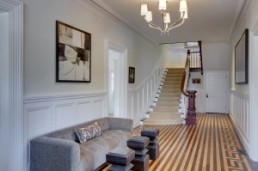The Newport Restoration Foundation recently honored Le Chalet with the 2012 Doris Duke Preservation Award.
Richard Morris Hunt, the “Dean of American Architecture”, designed Le Chalet on Bellevue Avenue in Newport in 1870. Hunt chose the Stick Style for the 9,700 square foot summer cottage after garnering significant attention for his Stick Style design of the Griswold House, now the Newport Art Museum. Hunt’s original plans for Le Chalet called for an ornate Stick Style edifice, extensive porches, cast iron roof cresting, and a large two-story carriage house. However, these plans especially the interiors, were believed to be scaled back at the time of construction.
Le Chalet had a succession of owners, each of whom made minor alterations to the home. When the clients purchased the property in 2010, the house has lost significant detail on it’s east elevation, was in a neglected state and warranted a full renovation. The design challenge was to adapt the home for a modern environmentally conscious lifestyle, retain the 19th Century character, and incorporate Hunt’s original vision for the façade and carriage house. The plan also called for a pool, pool house, outdoor kitchen and living room to be situated between the carriage house and main house. The architect replicated the original carriage house based on Hunt’s drawings that were located in his archives at the Octagon House in Washington, D.C.
The $3 million dollar project was completed in 2011 and features 12,000 square feet of living space. Exterior improvements include a new cedar shake roof, iron cresting, roof top deck, reconstructed chimneys, new windows, a new southwest porch, and a historic color palette. Interior improvements include a new infrastructure with geothermal heating and cooling, a new kitchen addition massed in to the southwest corner of the house, a new butler’s pantry that improves circulation to the formal dining room, and seven remodeled bathrooms. While renovating the front parlor, the design team located a fireplace buried behind a wall. The hearth was restored and now serves as a focal point of the room.



